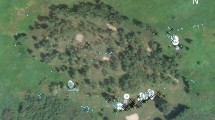Abstract
We report the extinction and colonization rates of five sympatric small mammal species at a semiarid locality in north central Chile. We provide information based on 6 years of monitoring on how colonization and extinction rates change according to landscape features (slope aspect) and on their relationship to populations size, population variability, and body size. We found that: (1) for all species in the assemblage, extinction rates of subpopulations from equatorial-facing slopes were significantly lower than those in polar-facing slopes, (2) population size was the most important factor determining extinction rates, (3) colonization rates did not vary between slopes, and were affected by population size only in equatorial-facing slopes, and (4) most species had higher extinction than colonization rates. Persistence of the metapopulation system for all five small mammal species appears to be fueled by repeated colonization events.
Similar content being viewed by others
References
Amarasekare P (1994) Spatial population structure in the bannertailed kangaroo rat, Dipodomys spectabilis. Oecologia 100: 166–176
Brown JH, Kodric-Brown A (1977) Turnover rates in insular biogeography: effect of immigration on extinction. Ecology 58: 445–449
Clark CW, Rosenzweig ML (1994) Extinction and colonization processes: parameter estimates from sporadic surveys. Am Nat 143: 583–594
Cook RR, Hanski I (1995) On expected lifetimes of small-bodied and large-bodied species of birds on islands. Am Nat 145: 307–315
Diamond J (1984) “Normal” extinctions of isolated populations. In: Nitecki MH (ed) Extinctions. The University of Chicago Press, Chicago, Illinois, pp 191–246
Foster J, Gaines MS (1991) The effects of a successional habitat mosaic on a small mammal community. Ecology 72: 1358–1373
Gaston KJ, McArdle BH (1994) The temporal variability of animal abundances: measures, methods and patterns. Phil Trans R Soc Lond B 345: 335–358
Hanski I (1991) Single-species metapopulation dynamics: concepts, models and observations. Biol J Linn Soc 42: 17–38
Hanski I, Gilpin M (1991) Metapopulation dynamics: brief history and conceptual domain. Biol J Linn Soc 42: 3–16
Hanski I, Gyllenberg M (1993) Two general metapopulation models and the core-satellite species hypothesis. Am Nat 142: 17–41
Hansson L (1977) Spatial dynamics of field voles Microtus agrestis in heterogeneous landscapes. Oikos 33: 539–544
Harrison SP (1991) Local extinction in a metapopulation context: an empirical evaluation. Biol J Linn Soc 42: 73–88
Hastings A, Wolin CL (1989) Within-patch dynamics in a metapopulation. Ecology 70: 1261–1266
Hastings A, Harrison S (1994) Metapopulation dynamics and genetics. Annu Rev Ecol Syst 25: 167–188
Jaksic FM, Feinsinger P, Jiménez JE (1996) Ecological redundancy and long-term dynamics of vertebrate predators in semiarid Chile. Conserv Biol 10: 252–262
Jiménez JE, Feinsinger P, Jaksic FM (1992) Spatiotemporal patterns of an irruption and decline of small mammals in northcentral Chile. J Mammal 73: 356–364
Johnson AR, Wiens JA, Milne BT, Crist TO (1992) Animal movements and population dynamics in heterogeneous landscapes. Landscape Ecol 7: 63–75
Kareiva PM (1990) Population dynamics in spatially complex environments: theory and data. Phil Trans R Soc Lond B 330: 175–190
Kingsolver JG, Schemske DW (1991) Analyzing selection with path analysis. Trends Ecol Evol 6: 276–280
Kozakiewicz M (1993) Habitat isolation and ecological barriers —the effect on small mammal populations and communities. Acta Theriol 38: 1–30
Lawton JH (1995) Population dynamic principles. In: Lawton JH, May RM (eds) Extinction rates. Oxford University Press, Oxford, pp 147–163
Levin SA, Powell TM, Steele JH (1993) Patch dynamics (Lecture notes in biomathematics 96). Springer, Berlin, Heidelberg, New York
Levins R (1970) Extinctions. In: Gerstenhaber M (ed) Some mathematical problems in biology. Mathematical Society, Providence, Rhode Island, pp 77–107
Li CC (1975) Path analysis. A primer. Boxwood, Pacific Grove, California
Lidicker WZ, Stenseth NC (1992) To disperse and not to disperes: who does it and why? In: Stenseth NC, Lidicker WZ (eds) Animal dispersal: small mammals as a model. Chapman and Hall, New York, pp 21–36
MacArthur RH (1972) Geographical ecology: patterns in the distribution of species. Harper and Row, New York
McArdle BH, Gaston KJ, Lawton JH (1990) Variation in the size of animal populations: patterns, problems and artefacts. J Anim Ecol 59: 439–454
Peltonen A, Hanski I (1991) Patterns of island occupancy explained by colonization and extinction rates in shrews. Ecology 72: 1698–1708
Pimm SL (1991) The balance of nature? University of Chicago Press, Chicago, Illinois
Pimm SL, Jones HL, Diamond J (1988) On the risk of extinction. Am Nat 132: 757–785
Roff DA (1974) Spatial heterogeneity and the persistence of populations. Oecologia 15: 245–258
Rosenzweig ML, Clark CL (1994) Island extinction rates from regular censuses. Conserv Biol 8: 491–494
Schoener TW, Spiller DA (1992) Is extinction rate related to temporal variability in population size? An empirical answer for orb spiders. Am Nat 139: 1176–1207
Shorrocks B, Swingland IR (1990) Living in a patchy environment. Oxford University Press. Oxford
Siegel S, Castellan NJ (1988) Nonparametric statistics for the behavioral sciences. McGraw-Hill, New York
Steel RGD, Torrie JH (1980) Principles and procedures of statistics: a biometrical approach. McGraw-Hill, New York
Tracy RC, George TL (1992) On the determinants of extinction. Am Nat 139: 102–122
Author information
Authors and Affiliations
Corresponding author
Rights and permissions
About this article
Cite this article
Lima, M., Marquet, P.A. & Jaksic, F.M. Extinction and colonization processes in subpopulations of five neotropical small mammal species. Oecologia 107, 197–203 (1996). https://doi.org/10.1007/BF00327903
Received:
Accepted:
Issue Date:
DOI: https://doi.org/10.1007/BF00327903




